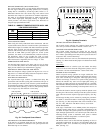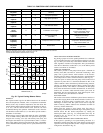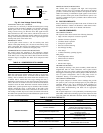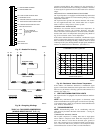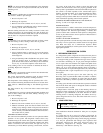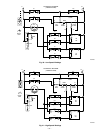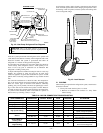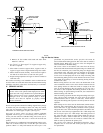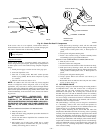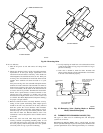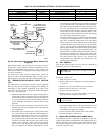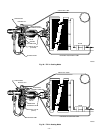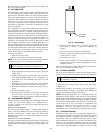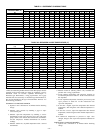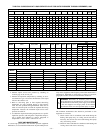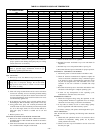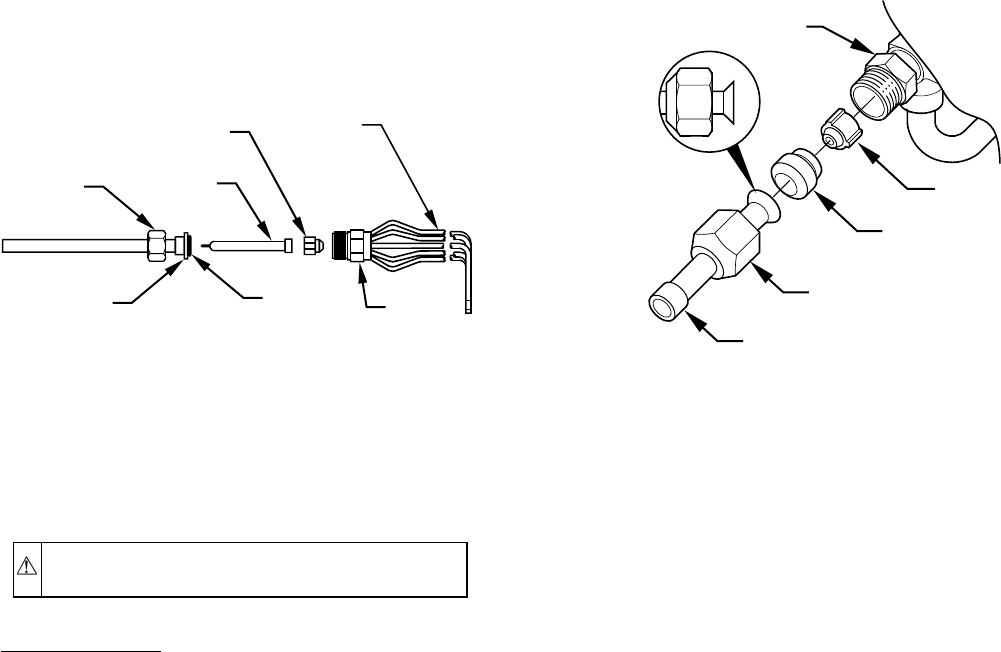
If the service valve is to be replaced, a metal barrier must be
inserted between the valve and the unit to prevent damaging the
unit exterior from the heat of the brazing operations.
CAUTION: Wear safety glasses and gloves when han-
dling refrigerants.
Pumpdown Procedure
Service valves provide a convenient shutoff valve useful for
certain refrigeration-system repairs. System may be pumped down
to make repairs on low side without losing complete refrigerant
charge.
1. Attach pressure gage to suction service-valve gage port.
2. Front seat liquid-line valve.
3. Start unit in cooling mode. Run until suction pressure
reaches 5 psig (35kPa). Do not allow compressor to pump
to a vacuum.
4. Shut unit off. Front seat suction valve.
NOTE: All outdoor unit coils will hold only factory-supplied
amount of refrigerant. Excess refrigerant, such as in long-line
applications, may cause unit to relieve pressure through internal
pressure-relief valve (indicated by sudden rise of suction pressure)
before suction pressure reaches 5 psig (35kPa). If this occurs, shut
off unit immediately, front seat suction valve, and recover remain-
ing pressure.
V. CHECK-FLO-RATER™ (BYPASS-TYPE) HEAT
PUMPS ONLY REFRIGERANT-METERING HOLE
THROUGH IT. THE RETAINER FORMS A STOP FOR
PISTON IN REFRIGERANT-BYPASS MODE AND A SEAL-
ING SURFACE FOR LIQUID-LINE FLARE CONNECTION.
(SEE FIG. 45.) TO CHECK, CLEAN, OR REPLACE PIS-
TON:
RELIANT PRODUCTS EXCEPT 1992 PRODUCTION
1. Shut off power to unit.
2. Pump unit down using pumpdown procedure described in
this service manual.
3. Loosen nut and remove liquid-line flare connection from
Check-Flo-Rater™.
4. Pull retainer out of body, being careful not to scratch
flare-sealing surface. If retainer does not pull out easily,
carefully use locking pliers to remove it.
5. Slide piston out by inserting a small, soft wire with small
kinks through metering hole. Do not damage metering hole,
sealing surface around piston cones, or fluted portion of
piston.
6. Clean piston refrigerant-metering hole.
7. Install a new retainer O-ring or retainer assembly before
reassembling bypass-type Check-Flo-Rater™.
RELIANT AND CUBE PRODUCTS PRODUCED IN 1992
1. Shut off power to unit.
2. Reclaim outdoor-unit refrigerant.
3. Loosen brass hex nut and remove line from brass hex body.
4. Slide piston out by inserting a small, soft wire with small
kinks through metering hole. Do not damage metering hole,
sealing surface around piston cones, or fluted portion of
piston.
5. Clean piston refrigerant-metering hole.
6. Always replace Teflon seal with new seal. Never try to
reuse old seals.
7. Reassemble brass nut and brass hex body. Be sure orienta-
tion is as shown in Fig. 45.
VI. REVERSING VALVE
In heat pumps, changeover between heating and cooling modes is
accomplished with a valve that reverses flow of refrigerant in
system. (See Fig. 46.) This reversing-valve device is easy to
troubleshoot and replace. The reversing-valve solenoid can be
checked with power off with an ohmmeter. Check for continuity
and shorting to ground. With control-circuit (24v) power on, check
for correct voltage at solenoid coil. Check for overheated solenoid.
With unit operating, other items can be checked, such as frost or
condensate water on refrigerant lines.
The sound made by a reversing valve as it begins or ends defrost
is a ″whooshing″ sound, as the valve reverses and pressures in
system equalize. An experienced service technician detects this
sound and uses it as a valuable troubleshooting tool.
Using a remote measuring device, check inlet and outlet line
temperatures. DO NOT touch lines. If reversing valve is operating
normally, inlet and outlet temperatures on appropriate lines should
be close. Any difference would be due to heat loss or gain across
valve body. Temperatures are best checked with a remote-reading,
electronic-type thermometer with multiple probes. Route thermo-
couple leads to inside of coil area through service-valve mounting-
plate area underneath coil. Fig. 47 and 48 show test points (TP) on
reversing valve for recording temperatures. Insulate points for
more accurate reading.
BRASS
HEX
BODY
TEFLON
SEAL
PISTON
RETAINER
BRASS
HEX NUT
STRAINER
PISTON
(ORIENT AS SHOWN)
FEEDER
TUBES
A91138
PISTON BODY
PISTON
PISTON RETAINER
INTERNAL STRAINER
FLARE ADAPTER
PRODUCTION
EXCEPT 1992
A94004
Fig. 45—Check-Flo-Rater™ Components
—39—



